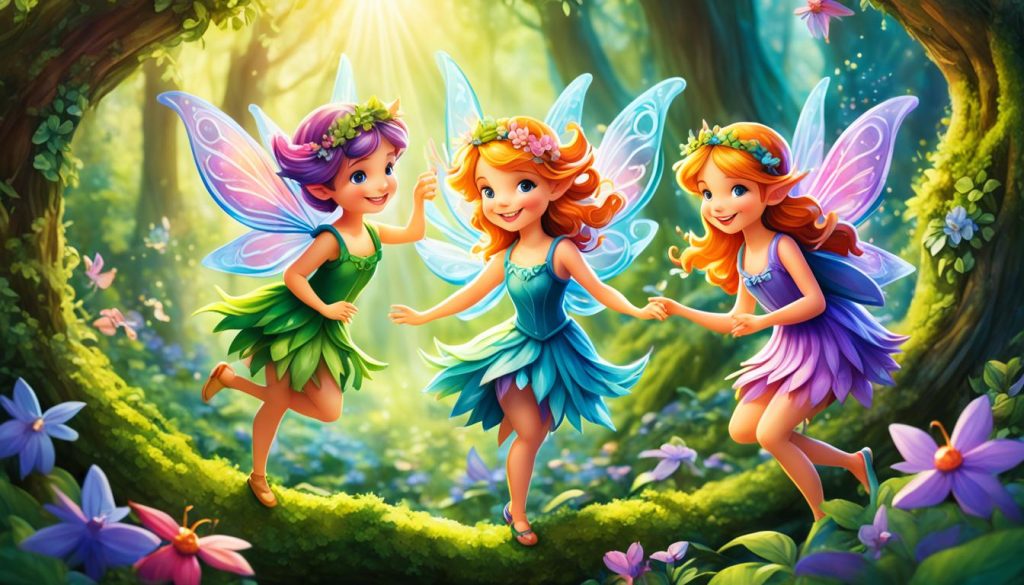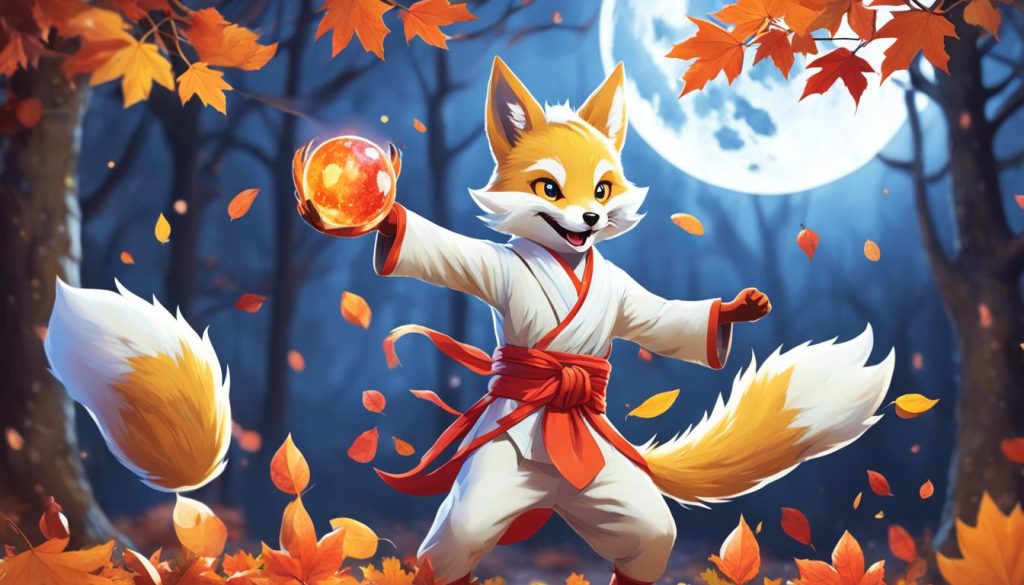Fairies have always caught the eye of people around the world. They started as kind spirits but turned into playful tricksters over time. This change shows how beliefs and stories have changed over the years.
In England, people’s view of fairies changed a lot in the early modern times. This change was due to the Catholic Church’s views and the lasting power of old stories.
Even though the law tried to link fairies with dark magic, writers like William Shakespeare kept changing how we see them. One fairy, Robin Goodfellow, kept causing trouble in homes during the 16th and 17th centuries. He showed how fairies can be both kind and tricky, highlighting the fight between magic and everyday life.
Key Takeaways
- Fairies evolved from benevolent spirits to mischievous tricksters in early modern England.
- The Catholic Church condemned fairies as demonic spirits, while the law courts associated them with witchcraft.
- Despite these efforts, the fairy spirit Robin Goodfellow continued to cause mischief in households.
- Robin Goodfellow embodied the dual nature of fairies, blending benevolence and malevolence.
- Fairies became a symbol of the ongoing battle between the supernatural and the mundane.
The Complex Nature of Fairies in Early Modern England
In early modern England, fairies were seen as both good and bad. They were often kind spirits who gave gifts to those who respected them. But they could also be mean, playing tricks on people without warning.
The Conflicting Perspectives on Fairies
After the Protestant Reformation, views on fairies changed. Protestantism led many to see fairies as evil, calling them old pagan superstitions. But, despite this, people still believed in fairies, especially in their homes.
The Enduring Presence of Robin Goodfellow
Robin Goodfellow, also known as Puck, was a well-known fairy from British folklore. He was known for being mischievous and sometimes mean. His name showed how fairies were also called the “good people,” even though they could be tricky.
Even though some tried to make fairies seem bad, they were still a big part of English mythology and popular culture. They were especially important in people’s homes.
Robin Goodfellow: The Disciplinarian of the Home
In early modern England, Robin Goodfellow was seen as a mischievous faerie. He was thought to keep order and cleanliness in homes. His home, Oberon’s realm, was a place without vice or disorder. He aimed to bring that moral order to the human world.
Oberon and the Fairy Realm
Being close to the fairy king Oberon gave Goodfellow a strong wish to push for hard work and neat homes. The fairies of Oberon’s court were known for being diligent and tidy. Goodfellow was their messenger, making sure humans kept their homes as clean and orderly as the fairies did.
Enforcing Order and Cleanliness
- Goodfellow was often shown with a broom, showing his help to domestic workers with their tasks and keeping homes clean.
- It was said that Goodfellow could punish lazy maids by pinching and nipping them, teaching them a lesson.
- His strict love for household cleanliness and hard work was key to keeping the moral order in homes.
Robin Goodfellow was seen as a key figure in keeping homes orderly and clean. He was a guardian of domestic life and the moral values of early modern English society.
The Price of Fairy Favors
In early modern England, fairies like Robin Goodfellow were not just kind spirits. They wanted a price for their help. Humans had to bargain with them to get good or bad luck.
The “Standing Fee” for Goodfellow’s Services
Robin Goodfellow, the helpful but tricky fairy, wanted a payment for his help. He got a “mess of white bread and milk” from housewives. If they forgot to pay him, he might take things from their homes, like grain and milk.
Customs to Appease the Fairies
Households also did other things to keep the fairies happy. They left out water for them to bathe in and milk and bread for their needs. These actions helped keep the fairies friendly and avoided trouble.
The price for fairy favors was key in early English life. It included paying Robin Goodfellow and following certain customs. These household rituals and supernatural deals were a big part of daily life.
The Mischievous Pranks of Robin Goodfellow
Robin Goodfellow was a famous fairy trickster in early modern England. He was known for his fun and sometimes cruel pranks. He could change his shape to sneak into human lives and play tricks.
In a 1625 ballad, Goodfellow talked about his shape-shifting skills. He said: “Sometimes I meet them like a man, sometimes an oxe, sometimes a hound, and to a horse I turn me can.” This skill let him surprise and play tricks on people in many ways.
Goodfellow loved to play fairy mischief. He might mess up a dinner, scare people in their sleep, or switch human babies with deformed fairy changelings. His practical jokes showed a mean side, adding a darker twist to his folklore tales.
Even though he was a trickster, people both feared and respected Goodfellow. His skill in changing shape and outsmarting humans showed how complex and powerful fairies could be. It made people wonder about the line between good and evil.
Fairies in Popular Culture and Folklore
Fairies have always fascinated people, crossing time and cultures. They appear in stories, art, movies, and even today’s beliefs. From Robin Goodfellow’s playful nature to the magical tales of the Seelie and Unseelie courts, these supernatural beings keep us intrigued.
The Enduring Belief in Fairies
Even when the early modern era saw belief in spirits as risky, people still believed in fairies. These fairy folklore beings could do good or bad. They helped with cleaning, kept servants in line, and could even make kids sick mysteriously.
Robin Goodfellow and others were seen as complex and interesting by the public back then.
Explaining the Unexplained
Fairies helped explain strange things people saw or experienced. They offered a way to understand supernatural beliefs and unexplained phenomena that science couldn’t explain. This mix of fairy folklore and popular culture kept people interested in these magical beings.
Fairies are still a big part of popular culture and folklore. They show our need to make sense of the unknown and explore the line between the natural and supernatural. As we try to understand the universe, fairies keep bringing wonder and magic to us all.
fantasy
The fantasy genre has always been magical, drawing us into a world of fairies. It’s a mix of epic adventures and magical realism. This blend has created some of the most creative stories out there.
At the core, world-building is key. Writers and creators have turned fairies into the heart of fantasy worlds. These worlds mix the everyday with the magical, making us feel amazed. They take us on epic adventures, where the impossible is real.
From the playful pixies in A Midsummer Night’s Dream to the mysterious elves in The Lord of the Rings, fairies are vital to fantasy. They let us see the world in new ways. Authors use them to talk about deep themes like mysticism and morality.

Works like Harry Potter show off amazing world-building. Game of Thrones takes us on big epic adventures. And Stardust mixes magical realism in a unique way. Fairies in speculative fiction keep inspiring us. They invite us into worlds where magic and reality meet.
The Trickster Nature of Fairies in Mythology
Fairies are known for being mischievous and trickster-like in fairy mythology and folklore. They often act with a mix of good and bad intentions. This makes them different from humans.
In fairy stories, there are Seelie and Unseelie Courts. The Seelie Court has fairies who help and are kind. The Unseelie Court has fairies who like to play tricks and cause trouble.
Fairies as Non-Human Entities
Fairies have their own set of values and behaviors. They act in ways that might seem strange or even wrong to humans. Their unpredictable nature makes them both interesting and a bit scary.
The Seelie and Unseelie Courts
Fairies are often split into the Seelie and Unseelie Courts. The Seelie Court has fairies who help humans. The Unseelie Court has fairies who like to play pranks and cause trouble. This shows how complex and varied fairy folklore can be.
The trickster nature of fairies is a big part of their stories. From Robin Goodfellow in English folklore to the kitsune in Japanese stories, these beings keep fascinating us. They can be good or bad, showing their complex sides.
Kitsune: The Japanese Trickster Spirits
In Japanese folklore, the kitsune, or fox spirits, are fascinating trickster entities. They can change shape and show both good and bad sides to humans.
Benevolent and Malicious Kitsune
Kitsune can turn into humans and have special powers. Some are kind and protect people or places. Others like to trick and play pranks on humans just for fun.
Kitsune Tricks and Illusions
The kitsune are known for their illusions. They can cast spells that make people see or think things that aren’t there. This is similar to the magic stories tell about fairies in European folklore.
Whether they are good or bad, the kitsune of Japanese folklore are captivating. They can move easily between the human and spirit worlds. This has made them a favorite in stories for many years.

The Allure of Fairy Tricksters
Fairy folklore has always fascinated writers, artists, and fans. At its core, the fairy tricksters stand out. They are mischievous and unpredictable, challenging our views and pushing limits. These beings live outside our moral and social rules, showing us other worlds and mysteries.
Why do people love fairy tricksters so much? It’s because they are fascinating and important in stories and culture. They break the rules of everyday life, making our imaginations run wild. They play tricks, give magical gifts, and challenge what we expect, showing us the magic of the unknown.
From Robin Goodfellow in English tales to the Kitsune in Japanese stories, these tricksters have become part of our stories. They make us question what we think is real. Their lasting appeal shows how much we love to discover the unknown and push beyond what we know.
Fairy tricksters capture our imaginations and broaden our view of the world. With their playful tricks and magical powers, they encourage us to see beyond the ordinary. They invite us into the enchanting world of fairy folklore, a realm that has fascinated us for centuries.
Conclusion
This journey into fairy tricksters has shown us their deep and lasting charm. They started in early modern England as both kind and playful spirits. Now, they still enchant us in popular culture and folklore.
Fairy tricksters are complex and sometimes hard to understand. They have become fascinating to writers, artists, and fans. As the fantasy genre changes, fairy tricksters will keep captivating us. They will continue to be reimagined, showing their cultural impact and future.
Whether they are the strict Robin Goodfellow or the changing Kitsune from Japanese stories, fairy tricksters keep fascinating us. They continue to inspire and enchant people everywhere.